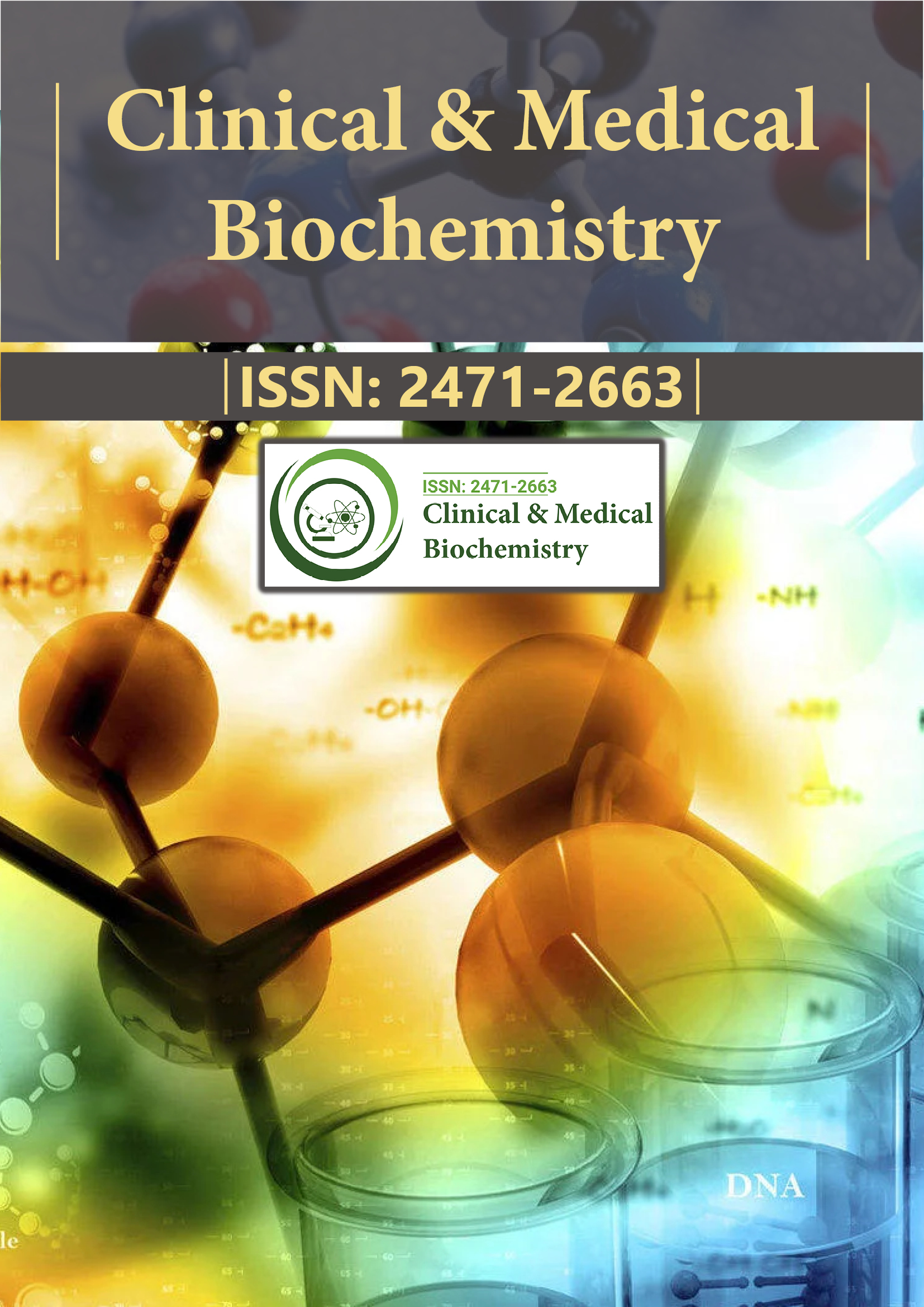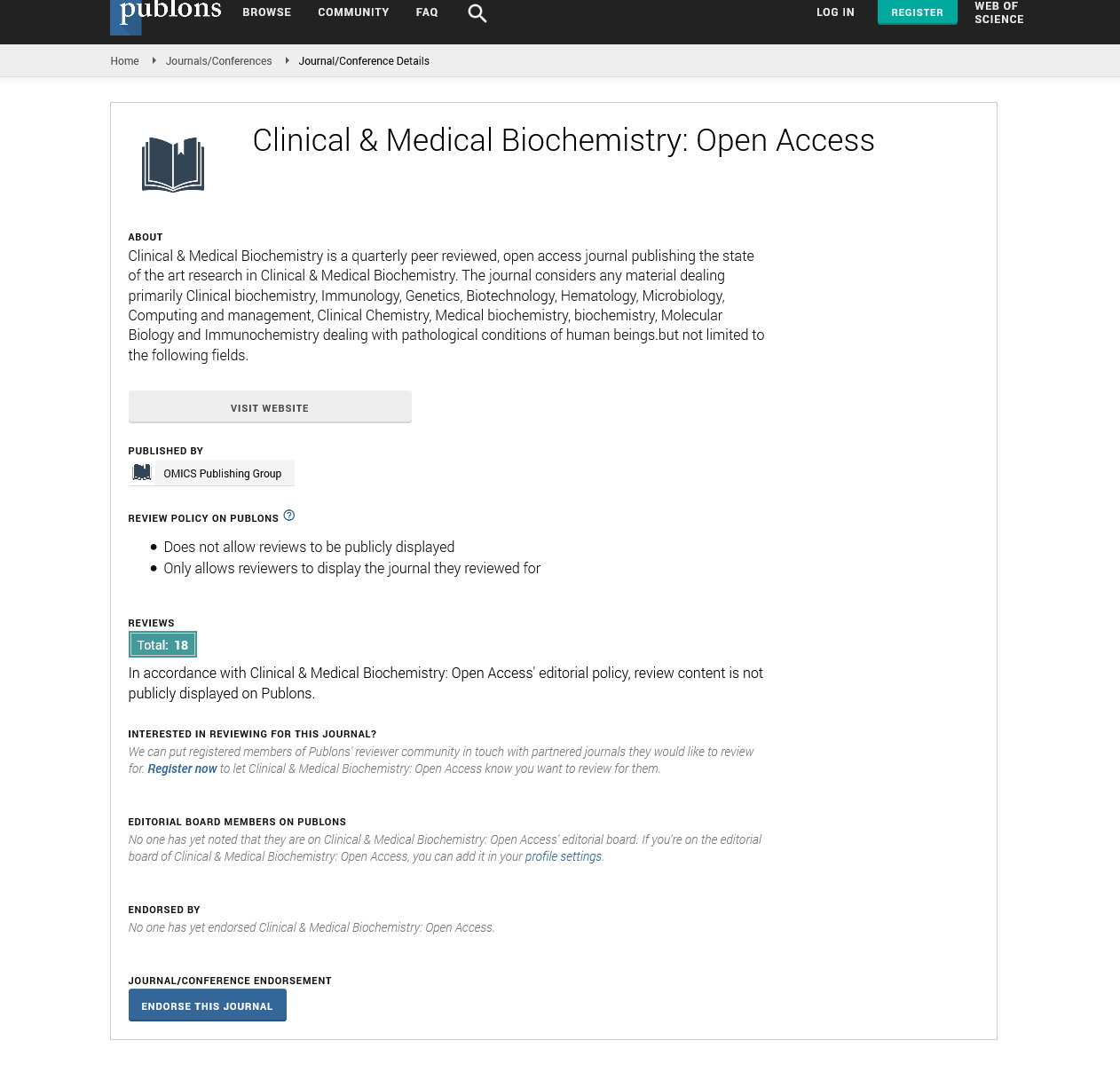Indexed In
- RefSeek
- Directory of Research Journal Indexing (DRJI)
- Hamdard University
- EBSCO A-Z
- OCLC- WorldCat
- Scholarsteer
- Publons
- Euro Pub
- Google Scholar
Useful Links
Share This Page
Journal Flyer

Open Access Journals
- Agri and Aquaculture
- Biochemistry
- Bioinformatics & Systems Biology
- Business & Management
- Chemistry
- Clinical Sciences
- Engineering
- Food & Nutrition
- General Science
- Genetics & Molecular Biology
- Immunology & Microbiology
- Medical Sciences
- Neuroscience & Psychology
- Nursing & Health Care
- Pharmaceutical Sciences
Opinion Article - (2025) Volume 11, Issue 1
Unlocking Heart Health: The Critical Role of Cardiac Biomarkers in Modern Cardiology
Joan Grant*Received: 26-Feb-2025, Manuscript No. CMBO-25-29232; Editor assigned: 28-Feb-2025, Pre QC No. CMBO-25-29232; Reviewed: 14-Mar-2025, QC No. CMBO-25-29232; Revised: 21-Mar-2025, Manuscript No. CMBO-25-29232; Published: 28-Mar-2025, DOI: 10.35841/2471-2663.25.11.243
Description
Cardiac markers, also known as cardiac biomarkers, are substances released into the bloodstream when the heart experiences damage or stress. These markers are indispensable in diagnosing and managing various cardiovascular conditions, particularly myocardial infarction, commonly known as a heart attack. Since heart disease remains one of the leading causes of death globally, timely and accurate detection of heart injury is essential. Cardiac markers provide clinicians with crucial information about the presence, severity and progression of cardiac damage, enabling prompt intervention and improved patient outcomes.
These markers are typically proteins or enzymes released from damaged heart muscle cells and they can be measured through blood tests. Their presence, concentration and timing are critical in determining whether a patient has suffered a heart attack and assessing the extent of the damage. Among these, troponins have become the gold standard for diagnosing myocardial infarction. Troponin I (cTnI) and Troponin T (cTnT) are proteins integral to the contractile function of cardiac muscle and are released specifically when heart muscle cells are injured. These troponins begin to rise in the bloodstream within 3 to 6 hours after injury, peak between 12 to 24 hours and may remain elevated for up to two weeks. Recent advances in high-sensitivity troponin assays have enhanced the ability to detect even minor cardiac injury earlier than ever, thereby improving diagnosis and treatment speed.
Before troponins took precedence, Creatine Kinase-MB (CK-MB) was widely used to detect heart muscle damage. CK-MB is an isoenzyme found primarily in cardiac muscle and shows increased levels within 3 to 6 hours after a heart attack, peaking between 12 and 24 hours and returning to normal within two to three days. This relatively rapid normalization makes CK-MB useful for identifying reinfarction, a subsequent heart attack that occurs soon after the initial event. However, CK-MB is less specific than troponin since it can also be elevated in cases of skeletal muscle injury.
Another early marker is myoglobin, a small oxygen-binding protein found in both cardiac and skeletal muscle. Myoglobin levels rise very quickly within 1 to 2 hours after cardiac injury, peak between 6 and 9 hours and typically return to baseline within 24 hours. While myoglobin is highly sensitive for muscle injury, it lacks specificity for the heart because it is released in response to skeletal muscle damage as well. Therefore, it is often used in conjunction with other cardiac markers to provide a more accurate early diagnosis.
Markers like B-type Natriuretic Peptide (BNP) and its inactive precursor N-terminal proBNP (NT-proBNP) differ from the injury markers mentioned above. These peptides are hormones secreted by the heart in response to increased wall stress, often caused by heart failure. BNP and NT-proBNP levels correlate with the severity of ventricular dysfunction and are widely used to diagnose and assess acute congestive heart failure. Beyond diagnosis, elevated BNP and NT-proBNP levels serve as important prognostic indicators, helping to predict patient outcomes and guide treatment strategies in heart disease.
C-Reactive Protein (CRP) and its high-sensitivity variant (hs-CRP) serve as inflammatory markers that have been linked to cardiovascular risk. Although CRP is not specific to cardiac injury, elevated levels of hs-CRP suggest systemic inflammation, which plays a significant role in the development and progression of atherosclerosis and other heart diseases. Measuring hs-CRP can help evaluate the risk of future cardiovascular events, making it a useful tool in preventive cardiology.
Clinically, cardiac markers, especially troponins, are invaluable in distinguishing between unstable angina and myocardial infarction. Elevated troponin or BNP levels identify patients who are at higher risk of adverse cardiac events, informing decisions about aggressive treatment, hospitalization, or closer monitoring. Repeated measurements of these markers help track the effectiveness of interventions such as thrombolysis, angioplasty, or cardiac surgery. Additionally, a second rise in CK-MB or troponin after initial normalization may indicate reinfarction, necessitating urgent medical attention.
Despite their strengths, cardiac markers are not without limitations. False positives can arise in conditions unrelated to direct cardiac injury, including renal failure, sepsis, or pulmonary embolism. The timing of blood sample collection is also critical, as early sampling may fail to detect elevated levels that rise hours after the injury. Consequently, cardiac marker levels should always be interpreted alongside clinical symptoms, Electrocardiogram (ECG) findings and patient history to ensure accurate diagnosis and appropriate management.
The evolution of high-sensitivity troponin assays has significantly transformed cardiac diagnostics by enabling the detection of even minor myocardial injury. Researchers are continuing to explore novel biomarkers such as copeptin, Heart-type Fatty Acid-Binding Protein (H-FABP) and microRNAs. These emerging markers hold promise for improving diagnostic accuracy and enhancing prognostic assessments, potentially allowing clinicians to better tailor treatments and improve patient outcomes.
Citation: Grant J (2025). Unlocking Heart Health: The Critical Role of Cardiac Biomarkers in Modern Cardiology. Clin Med Bio Chem. 11:243.
Copyright: © 2025 Grant J. This is an open-access article distributed under the terms of the Creative Commons Attribution License, which permits unrestricted use, distribution and reproduction in any medium, provided the original author and source are credited.

